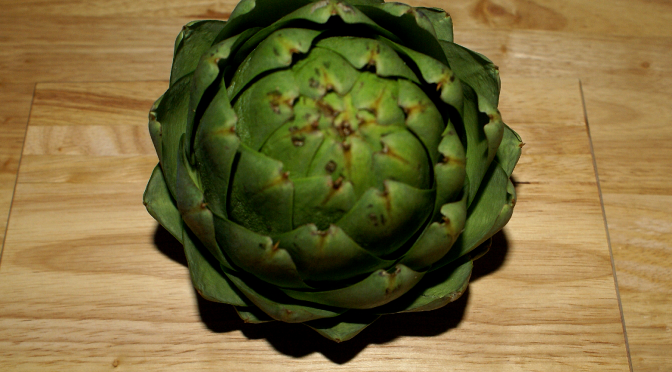I grew up eating artichokes,. In my house, as in many houses, the only way to eat them was to boil or steam the artichoke, peel off the cooked leaves one by one and dip them in either mayonnaise or a small bowl of melted butter with lemon. Delicious. Then when you got to the heart, you just savored the creamy, richness of it. But there are many recipes that use artichokes and I will be exploring more of these over the next year.
What is an artichoke anyway? Where did it come from and who on earth decided to eat this thorny-looking plant? Well, we can blame the Romans and the Greeks and just about anyone else in the Mediterranean area. In Rome, a variant of the vegetable called a cardoon was native to the area and widely enjoyed by the people in the region. While the plant was originally a wild species, the Greeks were cultivating it in the Classical period. By the 9th century, globe artichokes were grown around Naples. The vegetable spread across Europe and in the 14th century, the Dutch introduced it to the English court. It was grown in Henry VIII’s garden at Newhall. But it wasn’t until the 19th century that the artichoke arrived in America, traveling with the French to the New Orleans area and the Spanish to California.
The artichoke itself is a fierce-looking vegetable with a globe shape that can grow several inches in length. Each of its triangular leaves wrap around the heart or the center bottom of the vegetable and they are tipped with a sharp point. It also produces a beautiful purple flower, which makes it attractive in an ornamental garden.
When it comes to eating an artichoke, here are the key things to remember.
• Most of the vegetable is edible.
• You need to trim off the spiky points before cooking.
• The lower part of the leaf is the meaty part and is best scraped off with your teeth.
• Savor the tender leaves at the center that are covering the choke.
• Don’t eat the choke. It’s the fuzzy center of newly developing leaves and it pretty much will choke you if you try to swallow it.
• Do eat that lovely lump under the choke, which is the heart and is the real prize of the artichoke.
• Part of the stem is also edible so long as it is tender.
Preparing the Basic Boiled Artichoke
This is the method that both my family and PK’s family used. It is very much like the Romans prepared it long ago.
To prepare to cook the artichoke, begin by placing it on its side on a cutting board and use a sharp knife to cut across the top quarter of so of the leaves to make a flat top. Then use kitchen shears to trim the rest of the leaves down about ¼ of the way to remove the spikes and the tough part of the leaf.
The simplest way to cook an artichoke is to put on a pan of water big enough to submerge the whole artichoke. Bring the water to a boil then add a tablespoon of vinegar to the water, a little lemon and a teaspoon or more of garlic. Put the artichoke into the water with the stem bottom down in the pan. They may float to the top, so push them down and turn them often while cooking. Boil until a fork inserted in the bottom goes in and the leaves pull off easily.
Remove the artichoke and drain it in a colander, then prepare your dipping sauce. The basic one is mayonnaise, plain or with a little lemon. I added a bit of cayenne pepper the other night. You can also melt about 3 tablespoons of butter and add a ½ teaspoon of lemon juice to have a wonderful sauce. Or you can just pour some Ranch Dressing in a small bowl and dip the leaves in that. Many options work, so experiment around.
Artichokes are easy to share as an appetizer as two or three people can easily pull leaves and dip. When you reach the choke, use a spoon and a knife to cut under it and remove it. Then slice the heart into pieces and enjoy.
Nutritionally-speaking, the artichoke is good news for a low carb lifestyle and it is so good for your health.
Nutrition Info for one medium artichoke (about 3 “height from the base)
Calories: 60.2 Fat: 0.2 g Net Carbs: 6.2 g Protein: 4.2 g
Artichoke Trivia
Here are few interesting bits about the artichoke.
• In 2012, Worldwide production yielded 1,634,219 artichokes.
• The top production of artichokes was in Egypt with 387,304.
• The United State is ninth on the list of top growers with 51,300, but almost all of the US commercial crop is grown in California.
• Castroville, California is the self-proclaimed “Artichoke Center of the World” with over three-quarters of the artichokes grown in the U.S. coming from there.
References for this article include: Wikipedia, California Artichoke Advisory Board, and Oceanmist.com







